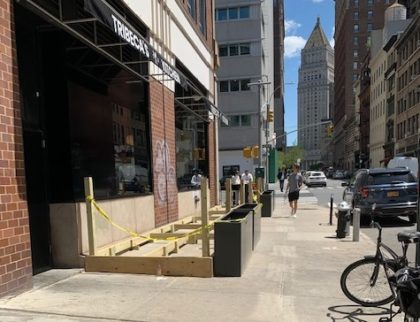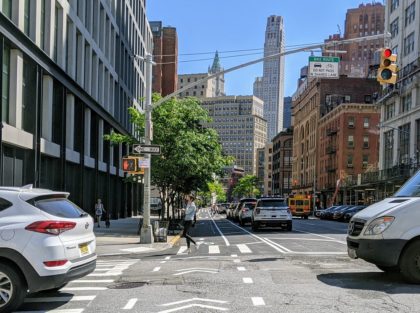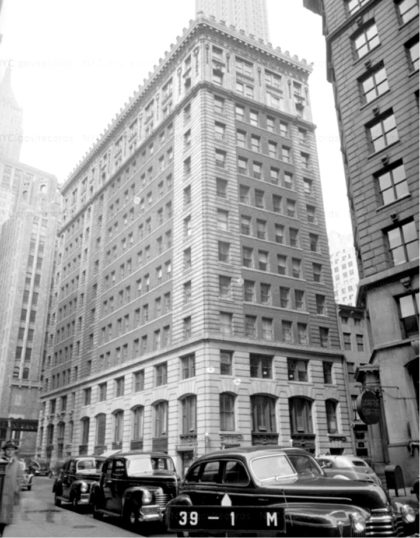Categories
Left column house ads
Seen & Heard: More outdoor seating for Tribeca’s Kitchen
May 17, 2021 Community News, Restaurant/Bar News
TRIBECA’S KITCHEN ON DUANE
Tribeca’s Kitchen is expanding its sidewalk seating on the Duane Street side of the restaurant. (Thanks to N. for the photo.) I did wonder how the restaurants with curbside structures already built in the area for the new bike lanes would be accommodated, and DOT told me this: We’ll be installing dedicated bike “detours” around the dining structures separated from traffic by a vertical element (like plastic delineators).
AND SPEAKING OF BIKE LANES…
The city has already installed the protected bike lane coming down Varick past the precinct, and it’s great. Much better solution and good to see the NYPD got with the program and no longer has a fleet of cars parked on the diagonal (though they do across the street). If you bike down Seventh much, it works great north of Houston, but that final leg between Houston and Canal is still dicey.
WALL STREET HOTEL COMING THIS FALL
The Wall Street Hotel — at 88 Wall between Water and Pearl — looks like it is moving forward and taking reservations for fall. They were in front of CB1 last week, trying to get a waiver for an ancient blue law that would not allow them to have a retail bar because their parent company owns a winery in Australia — and it doesn’t even export its product. *I know.* CB1 did not play along so they may be coming back next month?
STILL WAITING ON AKA TRIBECA
In thinking about the Wall Street Hotel, I thought of the shuttered aka Wall Street, then got to wondering about aka Tribeca, and it looks like that location is no longer on the website. But the hotel chain’s PR firm told me it’s still closed temporarily.
10 Comments
Comment:
Subscribe
Subscribe to the TC Newsletter

















Why are restaurants allowed to continue to make bigger outside seating areas when they are now permitted to run at full capacity? I have nothing against outdoor seating but it is time to put these sheds down. Tables on the sidewalk are fine but these big boxes need to go.
It may be news to you, but did you know there was this COVID pandemic thing for about a year or so, and that most restaurants were shut down here in New York City? I know, crazy, right? There is even a vaccine for the disease: https://www1.nyc.gov/site/doh/covid/covid-19-vaccines.page
Surviving restaurants’ fixed costs just didn’t evaporate because they can just now reopen at full capacity.
https://www.inc.com/diana-ransom/restaurant-revitalization-fund-small-business-administration-oversubscribed.html
” […] ‘Right now, SBA has more than $36 billion in applications from small, struggling independent businesses that will not receive funding,’ Sean Kennedy, the National Restaurant Association’s executive vice president for public affairs, said in a statement. What’s more, he added, thousands of businesses eligible to apply within the first 21 days still don’t know if their applications have been approved. The SBA was unable to say how many applicants had been notified to date. A spokesperson said the agency should have final data next week.
“That the program would run out of cash within the priority window was a concern from the start, said Kennedy, who noted previously that through January, the U.S. restaurant industry had lost an estimated $250 billion, and more than 110,000 U.S. restaurants closed permanently. As such, he added: ‘We continue to urge policymakers in Washington–from the White House to Capitol Hill–to replenish the RRF to maximize relief for small independent and franchise restaurant operators.’ “
Please consider the source that you have quoted. The National Restaurant Association is a lobbyist group. Of course they’re going to say there aren’t enough funds.
You can easily look up the amounts of PPP loans for restaurants in this zip code here: https://www.federalpay.org/paycheck-protection-program Every neighborhood restaurant I can think of is on the list, and if you can’t find a specific one, the LLC name is probably different than the name on the door. I would bet that some of the SBA money was funneled to pay for some, if not all, of the outdoor structures that are around the neighborhood. If the restaurants were so broke, how did they scrape up the funds to build such elaborate structures in some cases.
Yes, we all want restaurants to survive, but I would counter that some of the fixed costs did actually evaporate. Many of them did not pay rent while they were closed or re-negotiated profit sharing deals with the landlords.
I agree with K, this is a land grab and will be tough to unwind. So, in addition to navigating the double strollers and bike deliveries on the sidewalk, now we also need to navigate the servers carrying full trays of food. The sidewalks are public property and construction on them should not be allowed. It’s a slippery slope. What’s next? Tented restaurants covering all of the open spaces in parks?
Do you also object to the subsidized parking of automobiles in the streets? That’s what these structures are displacing. They generate way more in tax revenues and employment than free or cheap parking.
This basically bothers the NIMBYs who were used to holding up sidewalk cafes through community board control and/or antiquated, restrictive zoning. These outdoor dining programs have objective sidewalk clearance requirements.
See https://www1.nyc.gov/html/dot/html/pedestrians/openrestaurants.shtml#siting
If a structure or seating area falls to comply, call 311.
I assume you referring to placard abuse? I can assure you that the street cafes have not solved that problem in the least.
As for NIMBYism, seriously? It is so tedious to hear that argument. As if the people who live, work, go to school and volunteer here should somehow be valued less? Of course we care about our “backyard”. The people who use the neighborhood solely for profit are not economically inclined to care as much as the “NIMBYs”. Was Jane Jacobs also a NIMBY in your book?
If you’ve ever called 311, you’d know that it is akin to pushing a “walk” button at a traffic light. It is designed to absorb your anger over something, and that’s it. 311 is a joke; they do nothing. Re-read the threads on noise complaints from illegal parties in the neighborhood.
Re: Consider The Source
(1) I am not talking about placard abuse at all. (The bike riding on the sidewalk by people older than 12 is illegal; lax enforcement is a different story.)
The government already subsidizes automobile use with free or cheap on-street parking worth billions of dollars annually. The roadway cafes merely reallocate some of the “public” space from vehicle drivers to restaurants, and indirectly their employees, suppliers, and the dining public.
See https://www.nytimes.com/2018/06/18/opinion/a-fix-for-new-yorks-parking-problems.html
” […] Laid end-to-end, New York’s three million on-street parking spaces would stretch almost halfway around the earth. They would cover about 17 square miles of land, 13 times the size of Central Park.
” Because 97 percent of New York’s on-street parking is free, the indirect parking subsidy — what the city gives to drivers in the form of free parking — is astronomical. For example, if only half of New York’s on-street spaces were metered and the average revenue per space were only $2,000 a year ($5.50 a day), the total revenue would amount to $3 billion a year.
” There are other, indirect costs as well. One study of 15 blocks on the Upper West Side of Manhattan found that drivers cruised more than a third of a mile, on average, before finding an open space. In a year, this cruising created about 366,000 vehicle miles of travel and 325 tons of carbon dioxide emissions.
” If New York charges market prices for curb parking — the lowest prices that will produce one or two open spaces on each block — drivers won’t need to hunt for parking because they will always see open curb spaces available wherever they go. Parking won’t be free, but it won’t be scarce. […] ”
(2) How are the “the people who [..] work […] here” different from the “people who use the neighborhood solely for profit”? Who provides the services for the people who live here? Separately, zoning, land use, preservation, etc. are some of the biggest exclusionary forces.
(3) 311 requires persistence. It documents the problems and generates a data trail for you, which you can bring to the attention of your local precinct or councilperson if action is not being taken.
I think it’s a refreshing change to NYC. Restaurants went to great lengths to survive the virus and very creatively. Gives a little charm back to NYC.
Most things in life and business can be explained by economics and this situation is no different.
In this case, restaurant owners, their managers, consultants and on-line influencers, want local residents and politicians to believe that they are suffering, that street sheds are charming and therefore, it is our morale responsibility to support their expansion wishes despite the cost.
Let’s see: more outdoor tables = more customers = more opportunities to sell over-priced drinks = more profitable revenue.
Extended SBA or PPP loan programs (that will likely be forgiven) = lower operating costs.
More revenue + lower costs = more profits.
And, for those who remember their Econ 101 will recall, pollution – in this case jammed sidewalks, lack of parking, noise – is the negative externality. And, if pollution is not regulated, it will be consumed by pollutants infinitely.
We personally know two owners of restaurants downtown and both tell us that they are making more money than they ever have thanks to outdoor seating.
This expansion needs to be reigned back in and we need to return to having outdoor cafes and music governed by the long-standing permitting process.
I think it’s great, when done right. Some are just ugly plywood boxes, but others have made the effort (and clearly spared no expense) to make the outdoor eating areas beautiful and structurally solid. It can also alleviate sidewalk congestion created by sidewalk seating.
(Although I walked by a couple restaurants in our neighborhood the other night, which had large outdoor structures, but still added so much sidewalk seating, overflowing with patrons, that it was almost impossible to walk through there! So if anything the use of the street seating areas should be a way to eradicate such “sidewalk congestion” problem.)
aka Wall Street has new signage as an apartment rental building. Might be what aka is doing with their shuttered hotels.